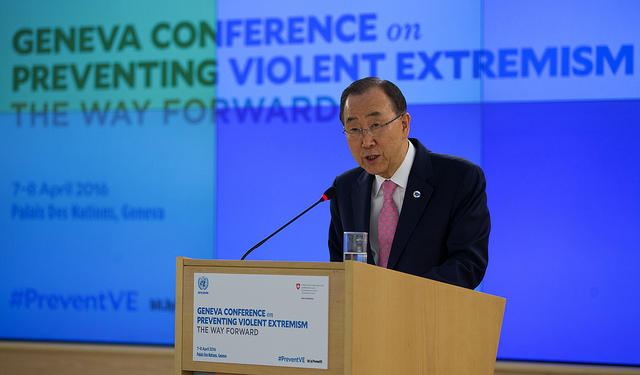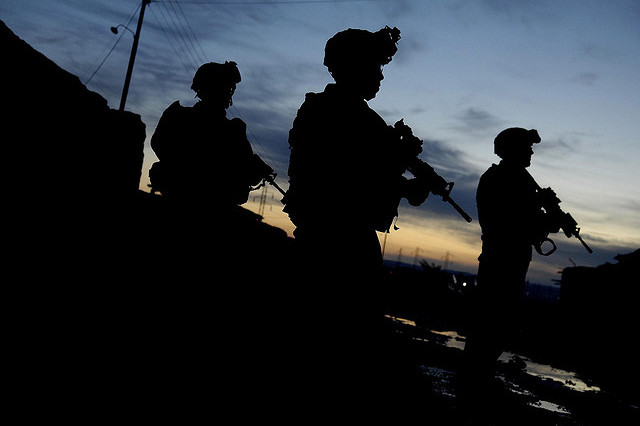by Diana Ohlbaum
As violence continues to escalate across the Middle East, one thing ought to be clear: the problem of terrorism cannot be solved militarily. It’s not just peaceniks who say this. Retired General James Conway and Retired Admiral James M. Loy acknowledge that “even the rise of ISIS cannot be resolved only with the force of arms.” Former defense official Rosa Brooks puts it simply: “we keep on killing bad guys, and the bad guys just keep on keeping on.”
To the rescue comes a new Department of State and USAID Joint Strategy on Countering Violent Extremism (CVE), which builds on an earlier USAID policy. Briefly, the logic is that in order to thwart the growth of terrorist groups, the United States must focus on the social, political, and economic drivers that spur people to commit or support violence. In practice, this means tactics such as bolstering anti-corruption efforts, expanding educational and employment opportunities, increasing access to justice, promoting ethnic and religious tolerance, and creating space for moderate voices and non-violent alternatives.
These are all worthy objectives in their own right, whether or not they lead to the specific end of preventing and disrupting terrorist recruitment, radicalization, and mobilization. Although individual projects have shown positive results, there’s not much research and evidence as to which approaches are most effective, and how, why, and under what circumstances. Since CVE is a relatively new field, and many of the activities are designed for quick impact, funders and implementers are only beginning to recognize the importance of rigorous evaluation.
Despite the best of intentions, these efforts face two inherent and overwhelming challenges. First, the level of resources for CVE is nowhere near commensurate with the scale of the problem. And second, the scope of the solutions is carefully circumscribed to avoid dealing with policies that contribute to the problem.
Figuring out how much the United States actually spends on CVE is difficult, since many programs have multiple purposes. The administration requested a total of $186.7 million specifically designated as CVE spending in FY17. But even if one were to count all the economic assistance programs conducted by the State Department and USAID under the category of “Conflict Prevention & Resolution, Peace and Security,” the total was just $751 million in 2014. That’s less than 1 percent of the $85 billion the Pentagon spent on the Iraq and Afghanistan wars in 2014—which does not even include operations by our intelligence agencies.
This points to the much larger issue: defining the problem as “violent extremism” or “terrorism” focuses attention only on non-state forces, which arise out of the brutality, incompetence, or failure of the state. Although the motivations of individual terrorists often remain unclear, the factors that are most strongly linked to the emergence of violent extremist organizations are the level of political violence committed by the state and the level of armed conflict within a country.
“Extremist violence” is the problem the United States has chosen to address because the government sees it as the most salient threat to U.S. national security. But why should state-sponsored violence be of any less concern? States that kill, torture, and oppress their own citizens, attack their neighbors, commit or condone pervasive corruption, or fail to uphold the rule of law are the ultimate drivers of extremist violence. Some of these states have aided and abetted the jihadist movements that pose the greatest threats to U.S. security. Some have blatantly violated international humanitarian law by raining indiscriminate destruction down upon innocent civilians. And U.S. arms, military training, and diplomatic support all too often have backed them up.
How can the one percent we invest in winning hearts and minds ever compete with the 99 percent we spend on destroying them?
Even the joint State Department-USAID strategy acknowledges this challenge, pledging that “State and USAID will work together to ensure that U.S. security assistance programming does not inadvertently exacerbate drivers of violent extremism by enabling or giving the appearance of endorsing weak or abusive governance practices.” But State and USAID are bit players in the Pentagon drama, and President Obama, while resistant to new military adventures, has been unable to effect a role reversal. Until the United States is ready to take a comprehensive, whole-of-government approach toward preventing violent conflict, CVE programs are likely to be little more than a tiny bandage across a gushing wound.
Photo: UN Secretary General Ban Ki-Moon speaking at the 2016 Geneva Conference on Preventing Violent Extremism (U.S. Mission Photo/Eric Bridiers via Flickr)






In the long run, this makes sense. What we have been spending on blowing people up (and not only terrorists, alas) dwarfs what we have spent on improving conditions of life in the Middle East. It may be good for arms producers and arm-chair strategists, but in the long run, like the Crusades (especially the Fourth), the militarized approach is not going to succeed. In the short run, we do have to defend Western interests, and, I would add, at least respect those of Russia, which has been a major victim of jihadist terrorism, starting in Chechnya in the 1990s, when some in the West quietly applauded the depredations of those “freedom fighters.” We should be making common cause on all fronts.